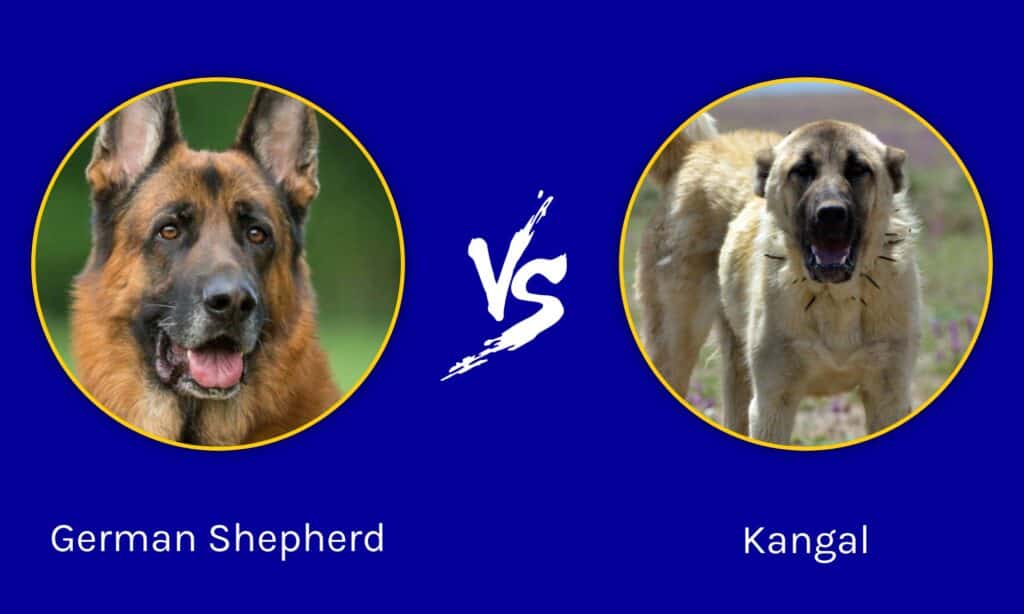German shepherd vs Kangal: which is stronger? Which makes the best family dog or livestock guardian?
The Kangal breed has one of the strongest bites among all dog breeds. This makes training and loving care even more important for safety and obedience.
German shepherds are well-known for their thick, luxurious coat and come in a variety of attractive colors like black and tan, solid black and solid white.
Let’s take a look at these shepherds in-depth to see how they compare!
Comparing German Shepherd vs Kangal

| German Shepherd | Kangal | |
|---|---|---|
| Size | 22-26 inches, 50-90 pounds | 28-32 inches, 90-145 pounds |
| Appearance | Medium-length double coat, upright ears | Short double coat, curled tail, floppy ears |
| Lifespan | 10-14 years | 12-15 years |
| Barking Level | Moderate | High |
| Recognition | AKC and UKC | UKC |
| Trainability | Eager to please but come with training challenges | Eager to please but come with training challenges |
Key Differences Between German Shepherd and Kangal
The major difference between German Shepherds and Kangal Shepherds is size. Other key differences include appearance, lifespan, and barking level.
Let’s dive deeper into these characteristics and look at the particular training needs of each dog below!
German Shepherd vs Kangal: Size

German shepherds are much smaller than the giant Kangal, weighing only 50-90 pounds.
©BIGANDT.COM/Shutterstock.com
The key difference between the German shepherd and Kangal is size, which makes a huge difference in the handleability of these dogs.
German shepherds weigh 50-90 pounds and are 22-26 inches tall. They’re large dogs, and not everyone can handle them!
However, Kangals are much larger at 28-32 inches tall and 90-145 pounds.
When adopting a large dog, it’s crucial to think about finances and handleability.
Can you hold the dog back on a leash? Don’t count on training them as puppies. Although training a dog young is a great plan, these pups get big and go through rebellious phases. They could very well be too large to handle before they’re fully leash trained.
Both breeds also have protective instincts and might not be friendly toward strange dogs and people, especially if they aren’t well-socialized when young. You must be able to contain them!
Also, consider emergency situations and what you’ll do if your dog loses mobility as they age. Lifting a dog this large isn’t easy!
When it comes to finances, Kangals will cost significantly more when it comes to food, veterinary bills, and other expenses.
German Shepherd vs Kangal: Appearance
German shepherds are muscular dogs with deep chests, medium-length coats, and, typically, upright ears. Unethically-bred German shepherds may have a sloped back, which is done for aesthetics and show purposes. In the United States, animal welfare laws are lacking and allow for this poor breeding of show dogs.
A sloped back can lead to joint problems later in life, which shepherds are sadly already predisposed to due to their size.
German shepherds can have the following coat colors according to the AKC breed standard:
- Black
- Black and cream
- Black and red
- Black and silver
- Black and tan
- Blue
- Grey
- Liver
- Sable
- White
- Bi-color
Kangal dogs are stockier in appearance than German hepherds. They have floppy ears and tails that curl onto their backs. They are short-haired dogs with double coats. The UKC breed standard accepts the following:
- Gold or grey fur
- Black mask
- Black ears
- Black tail tip
- Black spot in the middle of the tail
- Possible white chin, feet, or chest
Kangals cannot be solid black, white, or brown. Patterns such as piebald and brindle, extra white markings, and albinism are also disqualifying.
German Shepherd vs Kangal: Lifespan

Despite being giant dogs, Kangals live longer than German shepherds.
©daphnusia/Shutterstock.com
When it comes to lifespan, German shepherds sadly live a short life for their size. Their average lifespan is 10-14 years.
Typically, larger dogs live shorter lives. However, Kangals actually live longer with an average lifespan of 12-15 years.
These are averages, and not every dog will adhere to them. Some lucky pups live much longer, while others die younger. To give your dog a good and long life, feed them a balanced diet, exercise them daily, and bring them to the veterinarian regularly. And, of course, show them lots of love!
German Shepherd vs Kangal: Barking Level
German shepherds are moderate barkers. They’re most likely to develop problematic barking behaviors if they are bored or neglected. However, they do have guarding instincts and will often bark to alert. This can sometimes get out of hand without training.
Kangals tend to bark more as it’s part of their job as guard dogs. They might also “roar” at real or perceived prey. They don’t tend to make good neighborhood dogs for this reason and because they do best when allowed to work as they were bred to. Farm life is best for this!
German Shepherd vs Kangal: Recognition

Kangals aren’t recognized by the AKC and aren’t as common in the United States.
©ehasdemir/Shutterstock.com
The German shepherd is recognized by both the American Kennel Club (AKC) and United Kennel Club (UKC). However, Kangals are only recognized by the UKC.
While German shepherds are a super common breed and can be found in most shelters, Kangal shepherds are rare in the Americas.
German Shepherd vs Kangal: Training

It’s important to train both dogs well, and they each come with their challenges
©Roger costa morera/Shutterstock.com
The following are some training difficulties you might see with these dogs:
- Wariness or aggression toward strangers because of guarding instincts
- Kangals escaping from confinement due to their intelligence and high prey drive
- Running off due to both breeds having a high prey drive
- Behavioral problems due to lack of exercise, attention, or mental stimulation
Both have Strong Guarding Instincts
Guard dogs must be well-socialized in a safe way while young. However, Kangals may react worse to strangers coming near their property, family, or other pets. They’re very strong dogs and you don’t want them using their powerful bite force in inappropriate ways!
Both of these breeds tend to be highly affectionate toward family, but stand-offish and wary toward strangers.
Kangals are Escape Artists
Kangals are known for being incredibly smart—the Kangal Dog Club of America states that they’re smarter than a young child and jokingly adds that they can outsmart adults as well!
They love digging and should be given an appropriate outlet for this behavior. Adding an underground barrier to fencing is also a good idea to keep them enclosed.
Speaking of fencing, the Kangal Dog Club also notes that Kangals have been known to climb six-foot fences! Yours should be higher to account for this.
Both Shepherds have High Prey Drives
Neither Kangals nor German shepherds should be allowed off-leash in unenclosed spaces unless they have a very reliable recall. Recall is more difficult to teach in dogs with high prey drives, as they can focus on the hunt and forget their training.
These dogs’ prey drives are both a pro and a con depending on the person. It can also be both! For instance, farmers love Kangal shepherds for their ability to take down large predators.
But if you own a German shepherd in a neighborhood, you won’t want them chasing after the neighbor’s cats!
It’s important to put your dog’s instincts to good use. Even if you aren’t a hunter or farmer, you can allow your dog to “hunt” by giving them things to shred, like cheap toys or cardboard (so long as these activities are supervised and they don’t eat small pieces!).
Flirt poles and games of fetch are also great ways to stimulate hunting without actually letting your pup kill another animal.
They Need Plenty of Attention
Lastly, these dogs are high-energy, intelligent, and bred to work side by side with their human companions. They shouldn’t be left in the yard alone to amuse themselves or expected to stay in the house all day while you work.
They do best in families where someone is home throughout the day. However, it is important to teach them confidence in being alone by introducing the concept in a slow, positive way. This will help to prevent separation anxiety.
If your dog of either breed becomes bored or is neglected in the ways mentioned above, they’re likely to misbehave. You might see excessive barking or destructive chewing behaviors—and these are large dogs, so they can get into a lot of mischief with those teeth!
The photo featured at the top of this post is © iStock.com/cynoclub
Ready to discover the top 10 cutest dog breeds in the entire world?
How about the fastest dogs, the largest dogs and those that are -- quite frankly -- just the kindest dogs on the planet? Each day, AZ Animals sends out lists just like this to our thousands of email subscribers. And the best part? It's FREE. Join today by entering your email below.
Thank you for reading! Have some feedback for us? Contact the AZ Animals editorial team.






